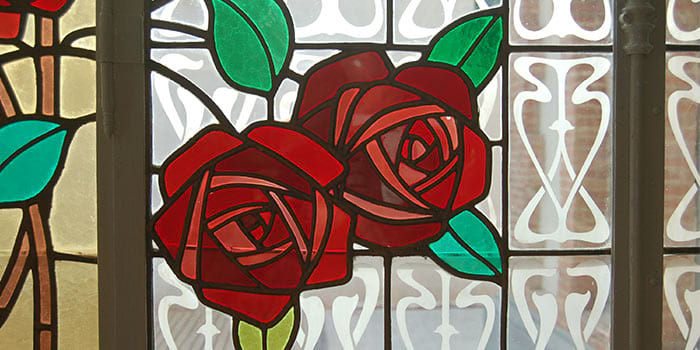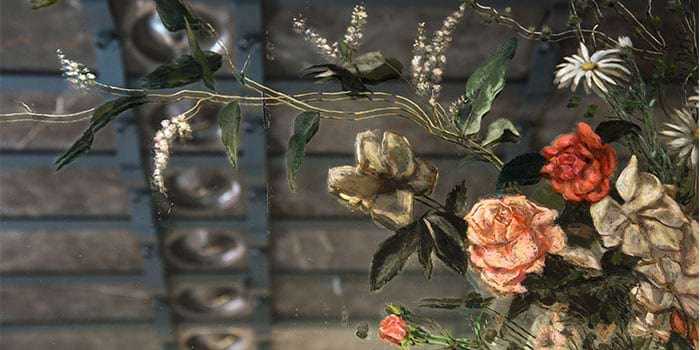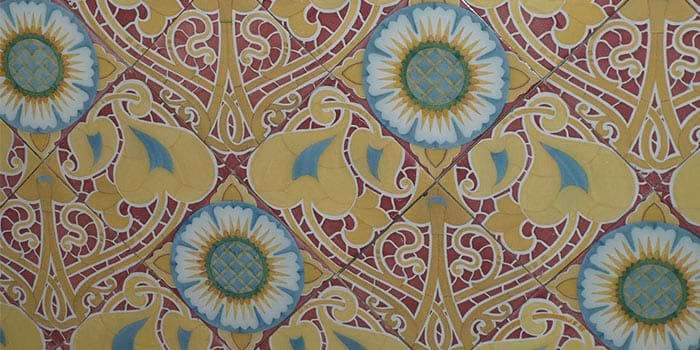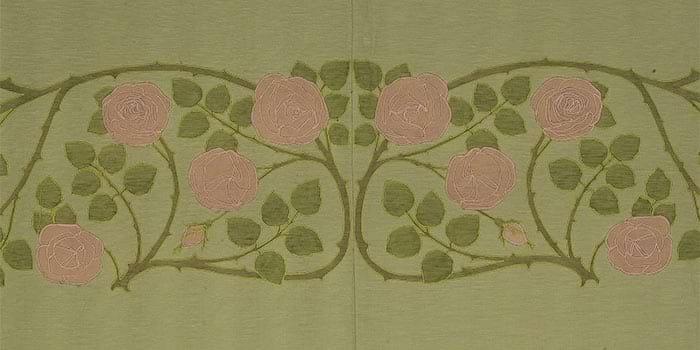
Museu d'Art de Cerdanyola

Palau Güell. Pintura de Ramon Tusquets sobre mirall. (Fotografia: Ramon Manent)

Museu Can Tinturé d'Esplugues de Llobregat

Museu Tèxtil de Terrassa
Art Nouveau roses for Sant Jordi
World Book Day or Sant Jordi on 23 April is the perfect time to explore the amazing Art Nouveau heritage of the regions around Barcelona. Using roses as our inspiration, we suggest a tour of five places that are a must-see if you love Catalan Modernisme, floral motifs and legends.
1. Palau Güell in Barcelona
We all know that plant motifs are one of the most common elements in Art Nouveau decoration, but few of us have realised how important roses are in the architecture, painting, sculpture and decorative arts produced between the late 19th century and early 20th centuries in Catalonia. Barcelona's Palau Güell is a great place to enjoy this symbolic flower in different formats and techniques, as there are roses hidden in furniture, mirrors, stained-glass windows, chairs and so forth. Take a good look! The house that architect Antoni Gaudí built for the Güell family early in his career stands out for its highly imaginative conception of light and space, but it also houses furniture pieces by Catalan decorators from the Modernisme period that are well worth contemplating up close.
2. Torre Vila in Montcada i Reixac
There are also interesting Art Nouveau villas in Montcada i Reixac, as this town in the Vallès Occidental region was one of the favourite destinations of the Barcelona bourgeoisie, when they were eager to escape the heat of the city during the summer months. It is precisely in one of these houses, the Torre Vila, that we find a window with roses that is truly amazing. Would you love to see it? Sign up for one of the Modernisme tours organised by the Municipal Museum and discover what this mansion, which was built in 1905, is like inside.
3. Cerdanyola Art Museum
More rose windows, this time blood red, can be found at the Cerdanyola Art Museum. They date back to the time when this building was the summer residence of Barcelona jeweller Evarist López and are made of acid-etched glass, cathedral glass and plaquette. Since you are there, do not miss the three panels of “Les Dames de Cerdanyola” (The Ladies of Cerdanyola), a crucial work of Catalan Art Nouveau stained glass, which have been restored and returned to their original location.
4. Can Tinturé Museum in Esplugues de Llobregat
The Can Tinturé Museum in Esplugues de Llobregat also features a rather unusual collection of ceramic pieces with rose motifs. On the one hand, there are three relief pieces where a luscious rose appears in all its splendour and, on the other, three tiles with a much simpler and more stylised design. They were produced at “La Rajoleta”, the former Pujol i Bausis ceramics factory which, during the Modernisme period, created tiles for the works of many of the great architects of that time. Yes, Gaudí, Domènech i Montaner, Puig i Cadafalch, Raspall and Sagnier were among their clients.
5. Terrassa Textile Museum
In the regions around Barcelona, Modernisme completely renewed architecture and the decorative arts, but its influence went further, as it had an impact on painting, sculpture, literature, music, graphic design and even the fashion of the time. You can check it out at the Terrassa Textile Museum, which houses a collection of clothing and fabrics that is a joy to look at. It brings together masterpieces by Catalan artists, designers and companies from the late 19th and early 20th centuries, whereas roses, embroidered or woven, feature in several pieces.
More information:
Museu Municipal de Montcada i Reixac Palau Güell de Barcelona
Museu d'Art de Cerdanyola
Museu Can Tinturé d'Esplugues de Llobregat
Museu Tèxtil de Terrassa

